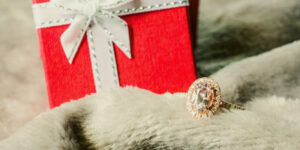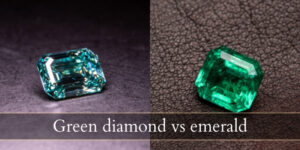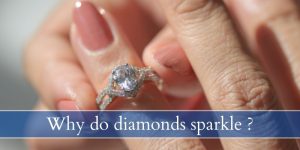Asscher cuts and emerald cuts are really elegant diamond styles and they often create a lot of confusion because of their striking similarities. Both are step-cut diamonds, both are notorious for showing any inclusion a diamond may have, and both look better with a higher color grade. In short, pretty classy diamonds that show off the gem’s quality.
Today we’re comparing the two cut styles, so you can see for yourself if an Asscher is really just a square emerald cut, or if there’s more to it than that.
Asscher cut vs emerald cut
Asscher cut diamonds are a square shape while emerald cuts are elongated rectangles and tend to appear larger than Asscher cuts. An Asscher cut diamond will have a distinct X or windmill going from the center to the corners, while an emerald cut does not. Asscher cut diamonds tend to have larger or wider corners tan an emerald cut, and thus more fire when compared to an emerald cut. It’s easier to find the perfect emerald cut diamond for your tastes because there are more available, while Asscher cuts aren’t as popular.
What is emerald cut ?
The emerald cut is a type of step cut derived from the old table cut. It has simple, clean facets that run parallel to each other, with cut corners forming angled facets. The overall effect of an emerald cut is a hall of mirrors or a set of stairs leading into the center of the diamond. This diamond cut style is an elongated one, with the most common length to width ratio is 1.30:1.
Emerald cuts have been around for centuries but they became quite popular in the Art Deco era when geometric patterns, angular shapes and clean lines were favored. Today emerald cuts are not as popular but still evoke class and elegance, with an understated glamor to them.
Read also: Fancy Cut Diamonds Explained
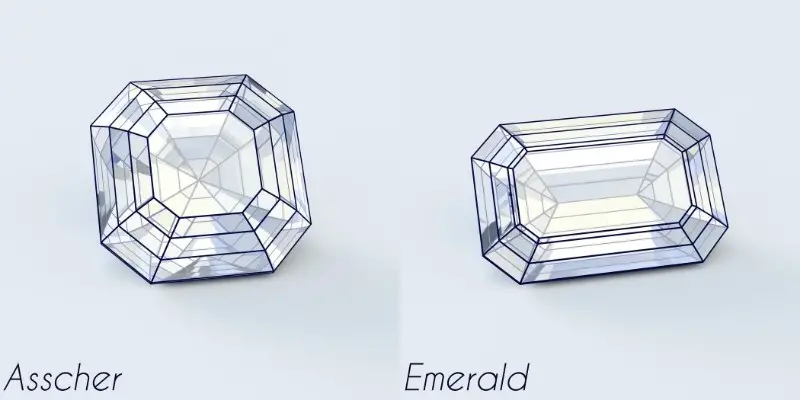
What is Asscher cut ?
The Asscher cut is another step cut diamond style, with a very sad and complex history. In appearance it resembles a squared emerald cut, with parallel line facets and cut corners, but its corners are wider and it often has variations that add extra facets on the pavilion. The corner facets form a noticeable X or windmill in Asscher cuts.
The original Asscher cut was developed by the Asscher family, who dedicated themselves to gem cutting, especially diamonds. They are still around today, and they’ve established the Royal Asscher Diamond Company in 1854. The Asscher cut diamond was designed and patented in 1902 and was a great success. But once WW2 started the Asscher family became Nazi targets as they were Jewish.
Most of the Asscher family and the company’s gemcutters and master polishers perished in concentration camps. Only 10 members of the Asscher family survived, and 15 of the polishers. In the meantime the patent for the Asscher cut has expired, so now there were many Asscher-like cuts floating around the world.
Some companies named their cuts Asscher, some named them squared emerald cuts, but none were cut to the same standards as the original Asscher cut specifications. To an outsider the original Asschers and the faux Asschers could’ve looked the same.
Today the Asscher cuts are patented, along with the variations produced by the Royal Asscher Diamond Company itself, such as the Royal Asscher.
Today’s Asscher cuts (originals) are laser-inscribed on the girdle, and the name and cut style is also patented. So if you’re currently looking at an Asscher, you should also be provided with a certificate of authenticity. Then again, if its one of the older diamonds form when the patent had expired, you might not get such a certificate.
Now let’s take a closer look at the difference between Asscher cuts and emerald cuts, and see just how different or similar they are.
1. Emerald cuts are elongated, while Asschers are perfect squares
Perhaps the first thing you will notice is that the emerald cut is by default a long cut style. An emerald cut will appear longer than an Asscher and because of this it will tend to look larger in general.
Long or elongated diamonds (or any gemstone for that matter) tend to make the finger look longer and more slender. There is a good and a bad way to do this, as too long or too skinny a diamond will make any finger look bad. The general ratio to look for is that of a traditional emerald cut, meaning 1.30:1 length to width. You can also get this with oval cuts, pear cuts, marquise, and radiant cuts, but today’s talk is about emeralds and Asschers.
Meanwhile the Asscher cut is a perfect square cut, or a nearly perfect one. The ratio is 1 to 1:1.05 which is a very faint difference. Now if you’re a big fan of square gems, then the Asscher will likely appear better to you. But what about the squared emerald, you ask ? In terms of proportions a squared emerald is not an exact square, the same way a princess cut is not an exact square. The squared emerald is usually a 1:1.1 ratio.
So if you’re ever confused about which diamond cut style you’ve got on your ring, first look at the proportions. The elongated step-cut ones tend to be emerald cuts not Asschers. Elongated Asschers are rare, and they have an open culet, so a very small window where the point of the pavilion would be.
2. Asschers have wider cut corners than emerald cuts
Another key way to see the difference between Asscher and emerald cut is their corners. Both have cut corners, but Asscher corners are wider. The overall outline of an Asscher is a nearly even-sided octagon. The corners or shoulders are almost the same width as the sides.
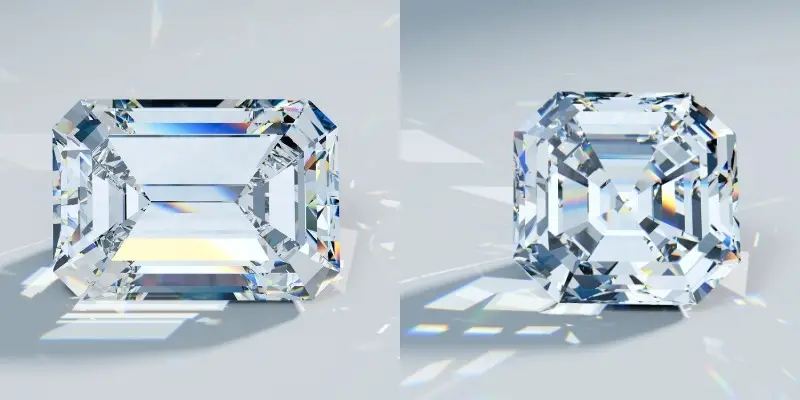
Compare this to an emerald cut, and you will notice the an emerald’s cut corners are significantly thinner than the short sides of the emerald cut.
This changes the overall look of the stone, but it also changes the angle of the light, and thus the brilliance and fire of the diamond. The result is that the Asscher cut is slightly more fiery than an emerald cut. There are overall less large facets that simply mirror each others, and more facets that bounce the light at an angle and offer fire instead of brilliance.
An emerald cut’s fire is more towards the ends of the diamond, where the angled cuts are, while an Asscher has this all around.
3. Emerald cuts have parallel lines, Asschers form an X in the middle
When you look at an emerald cut face-up you can see the faceting work quite plainly. Many facets facing each other, seeming like they lead down into the diamond. The facets leading from the cut corners go all the way to the long culet of the emerald cut.
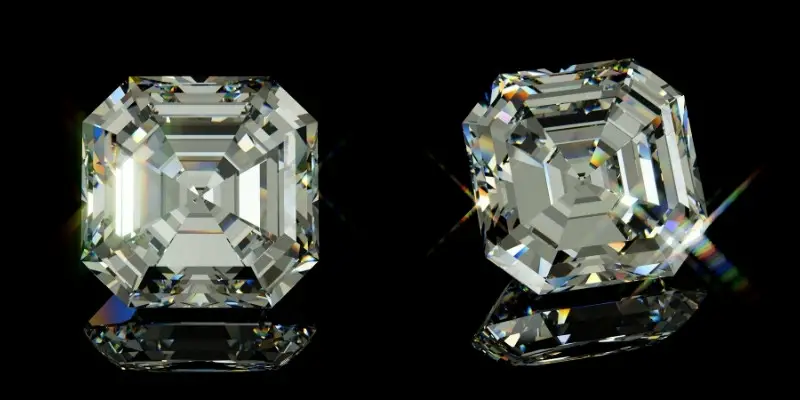
On an Asscher the facets leading from the cut corners also lead to the culet, but all 4 facet lines meet, forming a large X, or a sort of windmill if you like. This is a key way to check two things:
- if it’s a squared emerald cut, there won’t be an X but rather two Vs
- if it’s a well cut Asscher the windmill leads all the way into the center to a single point
There are Asscher cuts that have their corner facets stop before the culet, such as just 2 or 3 steps below the corners. A well cut Asscher should have an even-cut set of 4 facets leading form the corners, and all 4 of them should intersect in the middle.
4. Asscher cuts are bottom heavy, don’t face up as large as emeralds
This might just be details, but you’re paying a lot of money when buying a diamond so you might as well get the most bang for your buck. Now, due the the way an emerald cut is cut, it will face up larger than an Asscher cut. The pavilion is not as deep as an Asscher’s, and neither is the crown.
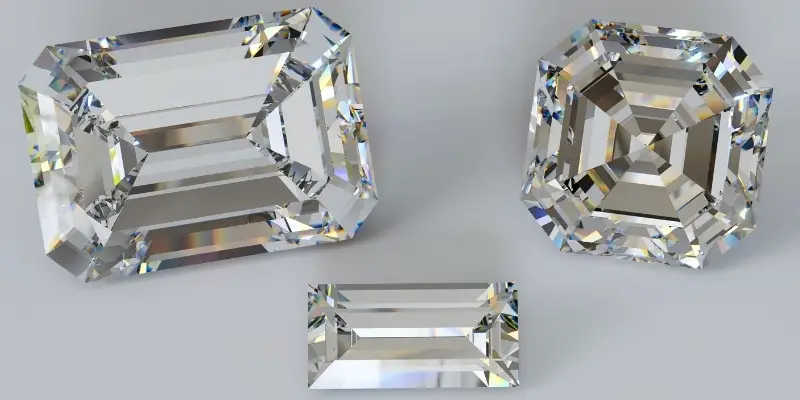
The original Asscher has quite a high crown with a smaller table, or at least a table smaller than an emerald cut table. So for example if you were to compare a 1ct emerald cut with a 1ct Asscher the emerald cut would appear larger than the Asscher. Most of the weight on an Asscher is in the pavilion, and then the height of the crown. It does not widen or lay as flat as an emerald cut does.
There is also the general shape to consider. An elongated diamond shape will always appear larger than a square or round shape, simply because it seems to take up more space. Other examples are oval or pear vs round cut, radiant vs princess cut, or marquise vs round cut. Anything that is elongated will appear a bit bigger on the finger than an even-sided diamond.
5. Emerald cuts are more popular and easier to find than Asscher cuts
Assher cuts are not the height of fashion currently, so you will have a harder time finding your perfect Asscher cut than your perfect diamond cut. This means that if you do go the Asscher cut route, you should not sacrifice on the cut grade, or the clarity. But color and size are where you can play a little and find something that looks good to you.
Emerald cuts are quite popular, even if they’re not as in-demand as a round brilliant or a cushion cut. But they’re still popular enough to be carried in various ratios and cut grades by jewelers and retailers so you should find a lot of options for your emerald cut.
Keep in mind that if you’re looking for a pre-made diamond ring, it’s easier to find it in emerald cut than in Asscher. And, if all else fails and you really can’t find the perfect Asscher cut for you, you could try looking at squared emerald cuts. They’re not 100% the same but they’re similar enough to maybe get you the look you’re going for.
Or, if you’re looking for something very angular and Art Deco but don’t want to go with an emerald cut, perhaps take a look at baguettes and kite/shield shapes.
Both Asscher and emerald cuts work great with a plain band
Whether you choose an Asscher cut or an emerald cut diamond, they have a very beautiful pattern of facets going on and it’s always nice to have them showcased on a plain band. Of all the diamond cut style out there, the step cuts always look great as solitaires on a plain band, regardless of metal color.
Of course you can always dress it up with a pave, or get a split shank, or have some side stones to get you the ring look you’re going for. We just think a plain band would let the diamond’s cut take up center stage.

I’m the main author for jewelrymaterialguide.com. I started this site after we did tons of research before our wedding and noticed that there is information about rings, jewelry, and so on that is really hard to find on the internet.


